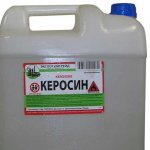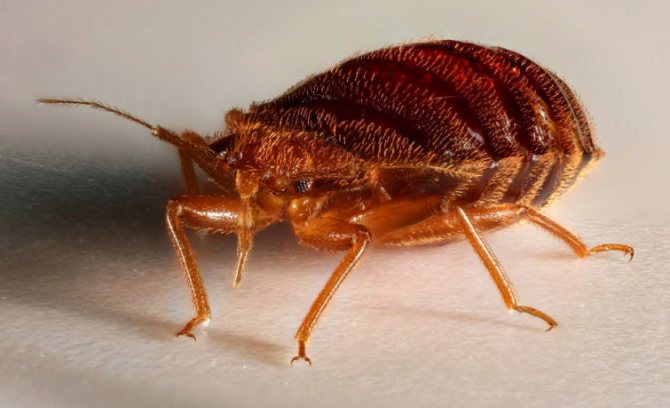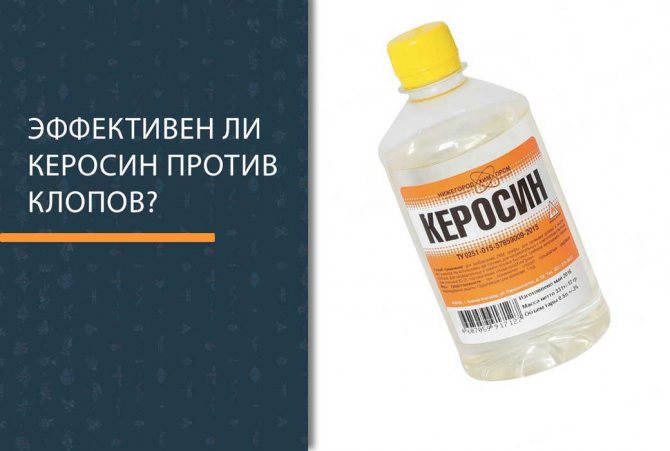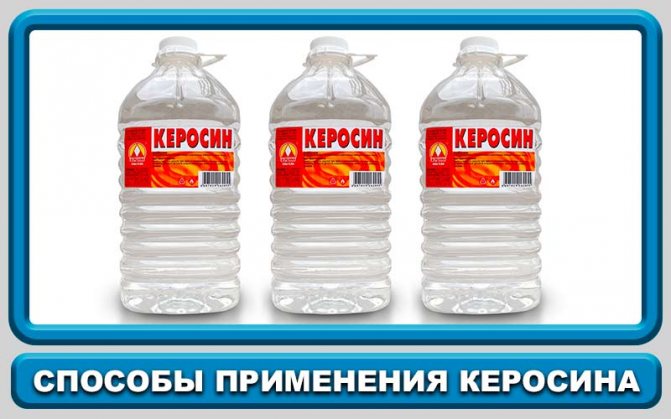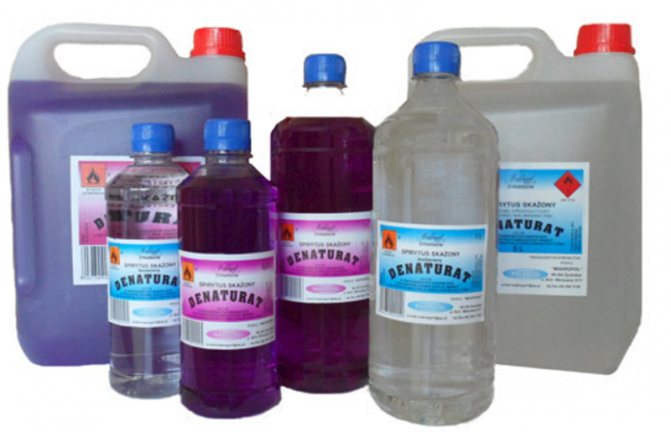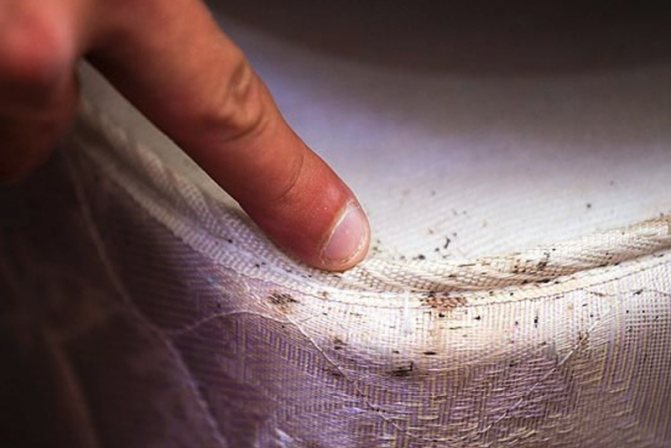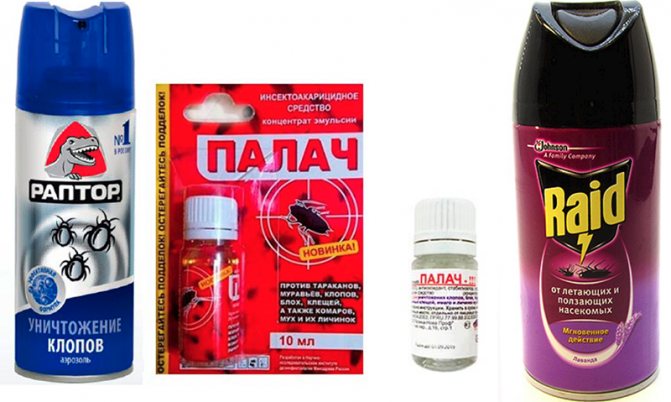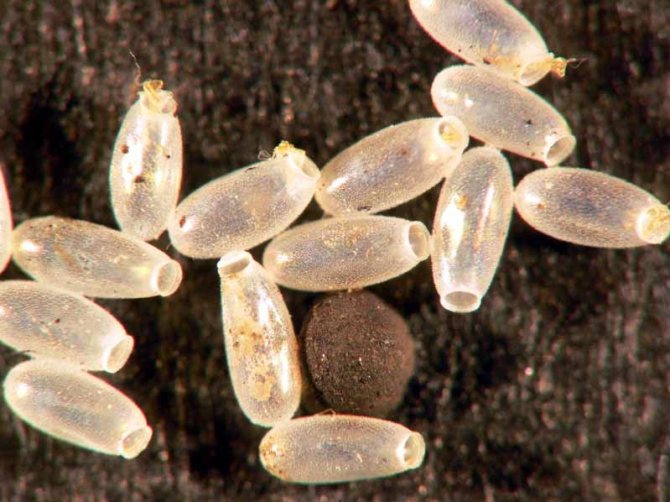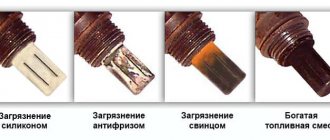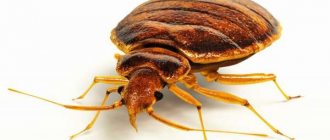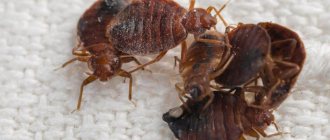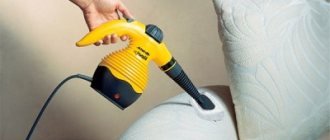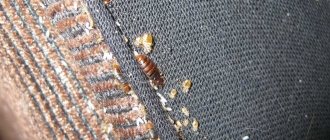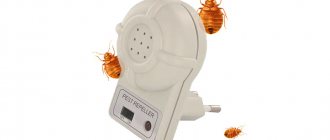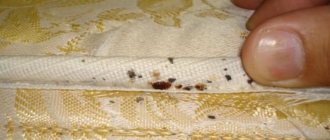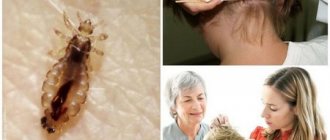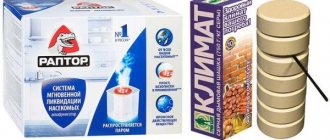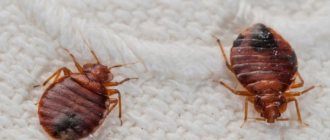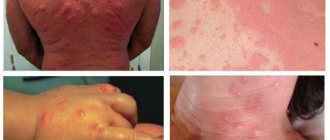It is difficult to say how often flammable fluids are used against bedbugs. But the fact that they, despite the abundance of modern insecticides, are still in use, is beyond doubt. Why, with all their shortcomings, the main of which are unpleasant odor and flammability, are they still used to fight bedbugs? The reason for the popularity of kerosene and denatured alcohol is obvious. This is affordability and low cost. For many thrifty people, these flammable liquids are stored in a workshop or garage for various technical purposes. And when bugs are suddenly discovered, of all the means that can be immediately used to combat them, kerosene and denatured alcohol are the fastest to remember.
How kerosene works on parasites
Kerosene, unlike modern chemicals, does not block the nervous system of bedbugs, but poisons insects. Death after the penetration of kerosene into the body of parasites occurs almost instantly. The bed bug chemicals we see on store shelves don't work that fast. It is worth noting the fact that kerosene destroys adults, larvae and eggs. Most insecticides do not kill eggs.
When parasites enter the body, kerosene blocks the work of the respiratory system. Insects breathe through the spiracles located on the body. Kerosene, enveloping the body of the bug, forms an airtight film. Oxygen starvation begins, which leads to the death of bedbugs.
Tansy from bedbugs in the apartment what you need to know
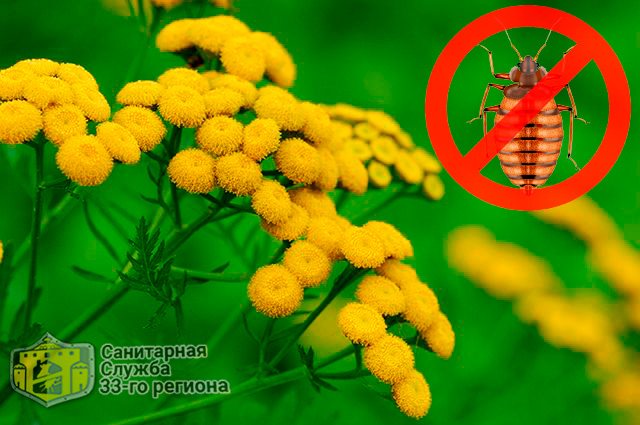
To begin with, it should be said that tansy has repellent properties, that is, its smell can scare off various insects, including mosquitoes. Bedbugs are also afraid of this smell.
But only if parasites have appeared in the dwelling and their nests are noticeable, it will be difficult to destroy them with tansy. In order to destroy the bug, it must be dipped in a decoction of this herb. Only then will the liquid enter the parasite's body through the respiratory tract. If you just treat the surface with a decoction, the bugs will continue to run around in the house.
Tansy with ant
But, so that the bugs are not so active, it is worth using tansy. If the parasites smell this herb, then for some time (about several days) they will not appear in the treated areas. Only later they will bite the person again.
Tansy from bedbugs can be used to treat a room as:
- Grass
- Solution (more on this later)
The use of this herb, like any repellent, is most effective as a preventive measure. In this case, it will really help protect your home from the penetration of pests. If your house is already a breeding ground for parasites, it will not always be possible to remove them with folk recipes alone.
Unlike pests that feed on plants poisoned by tansy, insects living in homes are not able to taste it. The fact is that adult moths do not have a mouth apparatus and do not need food, and bugs drink exclusively human blood. This means that the herb does not act as a poisonous drug on them.
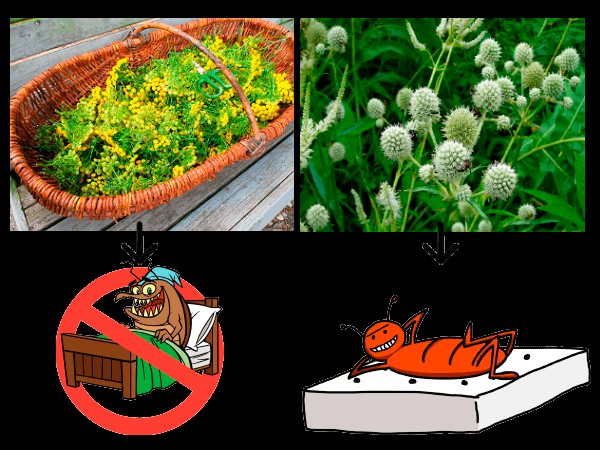

Of course, if you throw a bug into a concentrated decoction of a plant, a deadly dose will drop through the spiracles of the insect. But in reality this is hardly possible.And simply treated surfaces do not pose a mortal danger to pests.
As for the eggs and larvae of parasites, then any folk recipes are powerless in front of them. You can get rid of this scourge only mechanically (by processing things in a dry-cleaner or with a steam generator and throwing out contaminated products) or with the help of special insecticidal preparations.
Moreover, if before using herbal remedies, you do not take care of the preliminary destruction of larvae and eggs, this can lead to their subsequent immunity to this aroma.
So is this herb really powerless in the fight against moths and bedbugs? Not at all. For several days after treatment, adults will avoid appearing in these areas. This will provide the time it takes to find and eliminate their nests.
According to some reviews, tansy from bedbugs does not help and this may well be. There are several reasons for this explanation:
- Before using tansy against bedbugs, it is a good idea to find out the degree of contamination of the apartment. The plant is able to provide assistance when the situation has not yet been started and the pest population is small.
- Tansy doesn't kill! It scares away, therefore, with the weakening of the aroma, insects become more active. (
Strong hunger can make the pest ignore the smell after 60-70 hours after processing the apartment. Neither broth, nor fresh or dry grass has any effect on bloodsucker eggs. Even if one colony leaves the dwelling, a new generation will soon hatch and the struggle will begin anew.
Operating principle
The insect breathes with the help of spiracles, which are located over the entire surface of the body. Due to its oily composition, kerosene envelops the body, blocks breathing, and the bug simply suffocates. Acts immediately upon contact with the body. In addition, it can get inside and cause toxic poisoning. The bug does not withstand intoxication.
Smell plays an important role in expelling parasites. The bug uses the organs of smell to find food, a mating partner, and warns of danger. Kerosene acts on receptors, and the bug loses its orientation in space. A long stay in such a "fragrant" place does not allow the parasites to orient themselves, and they will soon leave the premises.
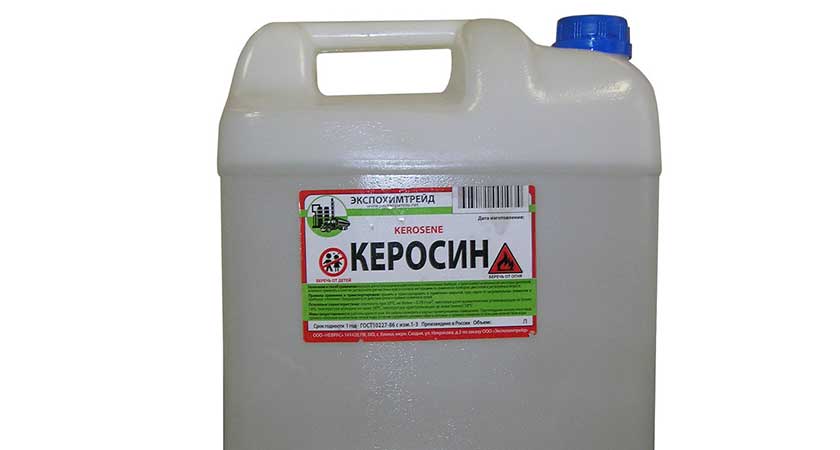

Of course, the greatest efficiency is achieved if the location of the nest is known. The bug dies within 2 hours. But it should be borne in mind that the agent does not work on eggs. Reapply after 7-10 days. Since during this time a new generation of bloodsuckers will appear. Kerosene can be used as a prophylaxis or to prevent re-infection, but it is not very convenient because of the unpleasant odor. In addition, the bug can adapt to it.
Kerosene attacks the respiratory tract of bedbugs and also acts as a deterrent. Bedbugs, like many other insects, breathe through the so-called spiracles, which are located on the body. Particles of kerosene, falling on the bug, envelop them in a thin film. They clog the spiracles, making it difficult for insects to breathe.
Sounds promising in theory. It would seem that it could be easier. Spraying kerosene, the bugs suffocate and die. But in practice, everything is not as effective as we would like. The effectiveness of killing bedbugs with kerosene is questionable, since:
- It is required to abundantly "bathe" the bug in kerosene so that it perishes.
- It is almost impossible to treat all the parasites indoors. That is, there is no guarantee that after processing, not a single bug will remain alive.
- Kerosene does not kill bed bug eggs. This means that in a week or two, the parasites will go hunting again.
- It is impossible to treat furniture upholstery and mattresses with kerosene, and as you know, these are the favorite habitats of insects.
Thus, the use of kerosene in practice is effective as a deterrent or for local destruction of parasites. For this, the nests and accumulations of bedbugs are poured directly with the agent.
If you want to experiment, be sure to use rubber gloves and a respirator. Do not carry out processing near sources of open fire.
“In practice, I will say that Dichlorvos is more effective. Neighbors used kerosene in the country. The stench was terrible all over the street. When the bugs started up in our country house, we used odorless Dichlorvos. Although it seems to me that even with the smell, it would not stink like kerosene. "
“In my opinion, the old-fashioned methods no longer work on modern bedbugs. They already had time to sniff this. We worn out, breathed and coughed while trying to remove them with kerosene. It is rather a test of human patience. In the end, exterminators were called in. "
“I remember this smell from childhood. Lice were taken out with kerosene and everything that was possible from bedbugs was disinfected. When these parasites recently appeared out of nowhere, I remembered this folk recipe. The kerosene didn't help this time. Bedbugs ran until we bought the Raptor. They were overjoyed early. After a month, the bugs began to bite again. They called in the service for the extermination of these parasites. I don’t know what they did there, but it was effective. ”
Industrial alcohol acts on bedbugs in much the same way as kerosene. And due to the fact that it evaporates faster, it turns out to be even less effective. Denature vapors evaporate faster from the bug's body, leaving it with a serious chance of survival.
If the bug got into a bottle of technical alcohol, then he, no doubt, died. But if the insect just turned out to be sprayed with denatured alcohol, it will be neutralized and disoriented for a while, but it will not die. The bug will come to his senses very soon and again take up his own.
But if, in spite of everything, technical alcohol was chosen to combat bedbugs, it is necessary to observe safety measures. Use of a respirator and gloves is mandatory. Before processing, it is necessary to remove people and animals from the premises.
“We played enough with this alcohol. The tool is affordable and inexpensive, but absolutely does not work. Where the bugs were found, they were poisoned there, but, apparently, they missed something, and after a few days they were right there again. The shop advised to buy the Executioner. I must say right away that there is no point in tormenting and saving. "
“Bedbugs appeared quite imperceptibly. We don't even know how long they lived with us until we found them. The husband brought technical alcohol. We decided to pour it over the baseboard. From there, bugs climbed. We did not have time to crush them. The apartment smelled awful. They immediately began to look for the number of exterminators. Since then, no bedbugs. "
“A friend advised me to treat the legs of the sofa with alcohol so that the bugs could not climb onto the sofa. Helped until the alcohol disappeared. Then I still had to buy a remedy for bedbugs. "
It is necessary to treat open space with a chemical, and hard-to-reach places where bedbugs accumulate - denatured alcohol and kerosene. Also, it is important to know how to prepare an apartment for pest control from bedbugs.
Kerosene is a product of the distillation of oil. Typically this flammable liquid is used as propellant or as a solvent for cleaning parts. Due to its insecticidal qualities, this agent is also used to combat various parasites. So, for example, kerosene is a very popular folk way to get rid of lice. They wipe the heads of patients with head lice and furniture, trying to destroy domestic bugs.
There are many recipes for insecticidal formulations, but first let's try to figure out why kerosene helps get rid of these parasites. It's all about the complex impact on pests. It not only poisons the larvae and adults, but also scares off bedbugs, preventing re-infection.
While modern insecticidal drugs paralyze the nervous system and muscle activity of insects, this chemical agent leads to the rapid poisoning and suffocation of parasites. Impregnating chitinous shells, this flammable liquid penetrates the respiratory system of insects, clogging the spiracles and blocking the flow of oxygen.
We offer you to familiarize yourself with Pests of raspberries and the fight against them
During the distillation process, oil is separated into various fractions, one of which is kerosene - a mixture of liquid combustible hydrocarbons used to flush various parts and as rocket fuel.
Once on the chitinous cover of the bed bug, kerosene closes the small holes on the insect's abdomen, leading to the trachea - respiratory organs that look like tubes that penetrate the entire body inside the parasite. These little holes are called spiracles. A thin kerosene film blocks the flow of air into the trachea through the spiracles, and the bug dies from suffocation. In theory, everything looks very convincing and reliable.
But does kerosene help with bedbugs in practice?
Unless you water them generously, but before that you also find out that it is not easy to do. This means that most of the insects will survive, their eggs will remain viable, the population will grow, prosper, and gnaw at household members.
Feedback on the use of kerosene against bedbugs from our readers
If someone set out to find out how the smell of kerosene affects bedbugs, they can continue the experimental part on repelling insects. Maybe some of them will be removed somewhere for a while until the smell disappears. But this is only for a while.
You can try to find clusters of parasites and pour over them all from the heart. But these nests are most commonly found in sofas and mattresses. And where to put them after such processing? It's easier to throw it away with the bugs.
But if someone wants to check how the old grandfather's methods of pest control worked, then it is better to protect yourself during such an experiment, namely:
- Protect yourself with gloves and a respirator;
- Before processing, ask everyone to leave the premises;
- Treat surfaces away from open flames.
Upholstered furniture, carpets and clothes cannot be treated with kerosene, since after that they cannot be restored.
How denatured alcohol and kerosene will definitely work for bedbugs
Denatured alcohol and kerosene from bedbugs work most reliably as deterrents.
- If parasites have been found in the room, the sofa and bed should be carefully checked. If there are no bugs here, but they are hiding in other places, with kerosene or denatured alcohol, you just need to process the legs of the furniture. Until the product wears off, the bugs on these legs will not be able to crawl up and bite a person.
- If bugs are destroyed by thermal methods - boiling water and steam - then it is with the help of kerosene or denatured alcohol that they can be taken out of places that cannot be reached by a jet from a kettle. For example, kerosene can be poured over the baseboards or in the cracks of the parquet, and then simply mechanically crush the insects running out of there or collect them with a vacuum cleaner.
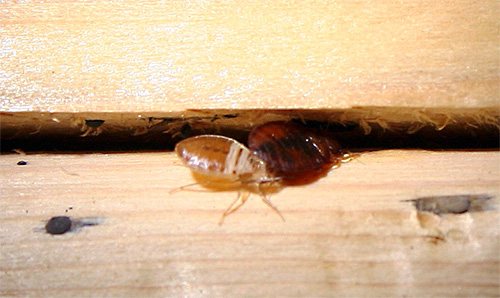

Finally, with the help of denatured alcohol and kerosene (or turpentine), you can protect yourself for several days even in a seriously contaminated room - the floor around the beds and sofas is thoroughly treated with the means, on which linen and pillows are changed. For three to four days, well-fed bugs will be afraid to run through the "barrier flap" and people will be able to sleep peacefully.
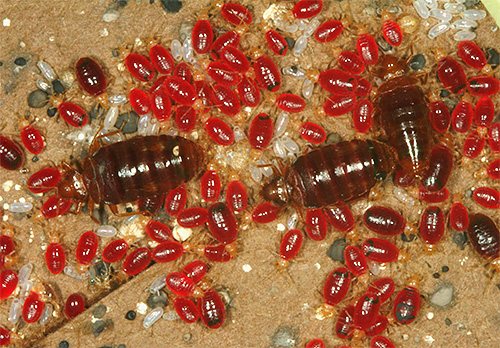

Feedback
“The bugs appeared somehow imperceptibly, they began to bite first me, then my husband. Even before the normal remedy, the plinth was poured with denatured alcohol - from there, this muck climbed like pus from a wound. When my husband began to press them, I almost twisted. I said that I would not survive this in the whole apartment. The stench was like in some service station. We ended up calling a team of exterminators, I went to my mother, and my husband stayed with them to supervise the work.When I returned, the bugs were gone. "
Inna, Stary Oskol
And quite certainly kerosene and alcohol work in conjunction with an effective insecticidal drug. So, for example, with denatured alcohol or kerosene, you can treat the most inaccessible places, expelling insects from there, and then poison them in open spaces with an inexpensive aerosol such as Dichlorvos-Neo or Raptor.
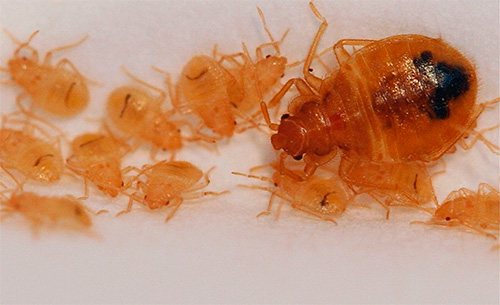

Important!
Popular folk recipes, in which kerosene or denatured alcohol are dismounted with naphthalene, is dangerous to use! Not only do the foundations themselves irritate and even burn the respiratory tract, but naphthalene, according to doctors, can lead to the development of cancer. These mixtures can be significantly more dangerous than bedbug bites.
It is also useful to read: Sprays and aerosols for bedbugs: which remedy is better?
And one more thing: We caught bedbugs and tested the effect of GEKTOR powder on them - it turned out to be quite a lethal thing ...
Does it make sense to use denatured alcohol against bedbugs?
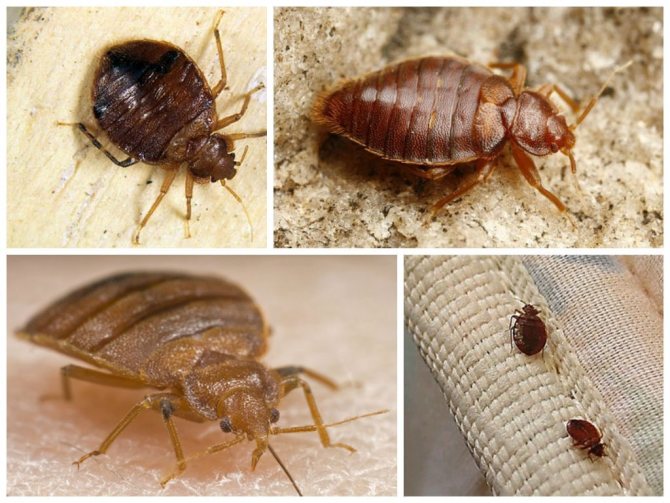

Despite the fact that denatured alcohol is very different in its chemical properties from kerosene, its effect on insects is exactly the same - an unpleasant odor and damage to the respiratory system. And since industrial alcohol has a higher volatility, it is even less effective as an antiklopina agent than kerosene.
Denatured alcohol acts on bedbugs in a similar way to kerosene.
An insect that will be abundantly moistened with denatured alcohol, of course, will die, but most will avoid this share, leaving because of the smell their usual place of stay, But then they will return again and take up their old occupation - bloodsucking.
How can denatured alcohol and kerosene still help get rid of bedbugs at least temporarily? Only by affecting their subtle sense of smell with its unpleasant odor. And this assumes the following way of using them.
You need to carefully check your bed or sofa for insects. If no bugs are found on them, you need to treat their legs with liquids. As long as the smell of liquids persists, the bugs will not be able to get close to their prey. You can process not only the legs, but also the floor around them. This will strengthen the protective barrier and reduce the likelihood of bed bugs entering the bed.
Another way to use kerosene and denatured alcohol is to pour them into the cracks where the bugs are hiding in order to expel them from there. But all these measures are temporary. As soon as the unpleasant smell subsides, the bugs will reappear.
More effective is the simultaneous use of kerosene or industrial alcohol and someone else's factory insecticide. Denatured alcohol and kerosene smell drive the bugs out of their shelter, and the aerosol insecticide finally destroys them. For these purposes, you can purchase inexpensive "Raptor" or "Dichlorvos-Neo".
Bedbug kerosene will only be effective if used correctly. Since bedbugs are miniature in size, they are able to hide in the smallest crevices, which become the favorite habitats of parasites. Therefore, the treatment of the premises is not limited to the formal spraying of kerosene on the floor and contaminated furniture. Pour liquid into each gap, process the space between the baseboards and walls.
Kerosene has a specific smell. Therefore, not everyone prefers to use it in its pure form. There are different options for preparing kerosene-based emulsions against bedbugs. We will look at 4 options that are used most often.
- Mix kerosene and ethyl alcohol in equal amounts. Add naphthalene or camphor oil, at the rate of 7 grams per 200 ml of liquid. After processing, the room should be ventilated.
- Mix kerosene, laundry soap, and naphthalene in a ratio of 5: 4: 1. The emulsion is ready to use.
- A popular remedy for fighting bedbugs is an emulsion consisting of kerosene, turpentine and naphthalene, which we take at the rate of 7.5: 2: 0.5.
- You can use an emulsion consisting of 9 parts of kerosene and 1 part of tobacco dust. But such a tool cannot be used immediately after preparation. It should be infused for 48 hours. Then, the composition is filtered.
Any of these remedies helps to get rid of harmful insects that cause a lot of inconvenience. After processing, ventilate the room, and do a general cleaning. Wash the surfaces treated with emulsions with a saline solution.
It is advisable to process the room at least 2 times. During the first treatment, some insects hide in air ducts, sewer pipes, etc. On some parasites, the emulsion could not get enough or not. To destroy the parasite, it must be doused entirely, which is not always possible.
We offer you to familiarize yourself with Moskitol from midges and midges: spray review
Separately, it should be said about upholstered furniture, which is a favorite habitat for bedbugs. It is undesirable to pour over any emulsions on a sofa or soft armchairs, which include kerosene. It is very difficult to get rid of the pungent smell later. It is advisable to use odorless insecticides for the treatment of upholstered furniture.
Does kerosene really help with bedbugs?
The action of kerosene against insects is based on two effects. Smell repelling and airway obstruction. Insects do not have lungs, they breathe through trachea, which are connected to the external environment by spiracles - small holes that protrude onto the surface of the parasite's body. When kerosene gets on it, it flows into the spiracles, and deprives the insect of the ability to breathe.
Thus, if a sufficient amount of liquid gets on the bug, it dies from a lack of oxygen. The same thing happens with lice when they are removed with kerosene. But in order to kill insects, they need to be abundantly moistened with liquid, which, for obvious reasons, is not so easy. So it is impossible to call kerosene an effective remedy against bedbugs with all desire. It must also be taken into account that neither kerosene nor denatured alcohol is capable of destroying bedbug eggs.
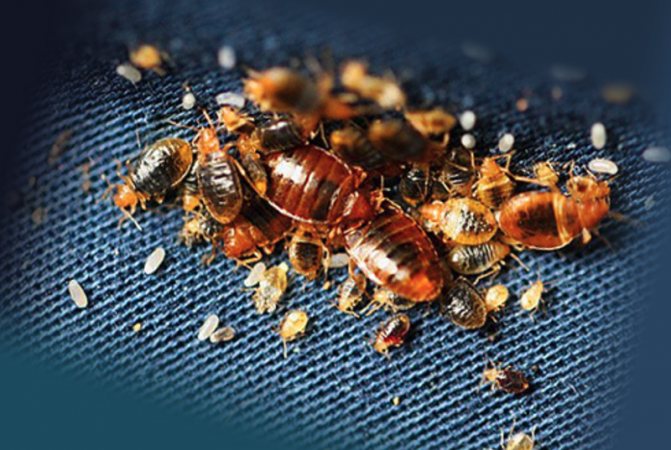

Let's summarize the above. You can get rid of bedbugs with kerosene only by scaring them off with its smell or by abundantly wetting the discovered bug nest. And since the latter, as a rule, are placed on a mattress or upholstery, the destruction of bedbugs is tantamount to making furniture unusable.
It is possible to successfully destroy bedbugs with kerosene and denatured alcohol only by finding and processing their nests.
Feedback
We had an old neighbor in our village who constantly fought with bedbugs and other pests in an old-fashioned way, the main of which was kerosene. It was not even possible to enter his house, it smelled so much of kerosene. I do not know how his bedbugs felt about this, but my grandmother did not welcome such a method of struggle. She used dichlorvos, said that it was much more effective and easier.
Olga, Kursk
Rules for the use of kerosene
The instruction is not much different from the use of insecticidal preparations. Kerosene is toxic, can cause poisoning or an allergic reaction if it comes into contact with the skin or mucous membranes. If used improperly, not only the bug, but also the person can suffer. In small doses, if ingested, or if a person breathes in vapors for a long time, a narcotic effect and a state of euphoria occurs.
- A respirator or mask, rubber gloves and a suit must be worn. There should be trousers and a long-sleeved jacket.
- If the product accidentally gets on the skin, eyes, nose, mouth, rinse well with water.
- If kerosene gets into the stomach, induce vomiting, take activated charcoal and seek medical help.
- The processing of the premises is carried out with open windows and doors. If a person feels weak or worsening, stop working and go out into the fresh air.
- There should be no other people or animals in the room.It is better to send children to relatives, since the smell will remain in the room for a certain time.
- Kerosene is highly flammable. Both the bug and the person can be left without housing. The house should not burn gas, fireplace, smoke, light a candle and do not use matches.
- Only a hard surface is processed, since kerosene can damage textiles, carpets, upholstery and impart an unpleasant odor to them. Wipe down furniture, floor, baseboards, back of paintings, clocks.
After processing, ventilate the room well. It is recommended to carry out wet cleaning 2 days after processing. The bug will die during this time. Then you will need to monitor the emergence of a new generation, and re-pest control.
Kerosene is used to fight parasites along with turpentine, vinegar and denatured alcohol.
To do this, chemicals are applied to the habitats of bedbugs, as well as all holes and crevices that can give them temporary shelter during pest control. For the effect to be complete, the liquid is injected in sufficient quantities as deep as possible into the cracks in order to abundantly wet the pests and their larvae.
In this case, the room can be treated with the agent in its pure form or it can be introduced into various compositions. For example, one hundred milliliters of kerosene can be mixed with the same amount of ethyl alcohol and 5-7 grams of naphthalene or camphor oil. Spray the infected areas with a solution, and then ventilate the area. To consolidate the effect, re-treatment should be carried out no later than three to five days.
There are other recipes for emulsions:
- Mix 5 parts of kerosene, 4 parts of laundry soap, 1 part of naphthalene;
- 7.5 parts of kerosene, 2 parts of turpentine, 0.5 parts of naphthalene;
- Or add 1 part of tobacco dust to 9 parts of kerosene, insist the solution for two days and filter.
A very effective old recipe for blood-sucking parasites is a solution of turpentine, kerosene and boiling water. You just need to mix all the components in the right proportion and apply to the wooden surfaces of the furniture. If necessary, soap can be added to the composition. The proportions are as follows: 150 ml of water, 20 ml of kerosene, 15 ml of turpentine and 40 grams of soap. In general, there are a lot of similar recipes.
Kerosene is toxic not only to bedbugs, but also to humans. Causes poisoning when in contact with the skin and mucous membranes, long-term inhalation of vapors leads to drug intoxication. The nervous system and liver are affected. Therefore, it is necessary to take safety measures:
- Free the treated premises from residents and pets. Send children to relatives for a few days.
- A respirator can be used to protect the respiratory system. The skin can be protected by clothing with long sleeves and pant legs. Put gloves on your hands.
- Pest control should be carried out in a well-ventilated area. If it becomes bad, then it is necessary to stop processing and go out to breathe fresh air for a while.
- If the skin, eyes, nose and mouth are damaged by kerosene, rinse them abundantly with running water.
- If kerosene enters the stomach, induce vomiting and consult a doctor.
- Since kerosene is a highly flammable substance, it is forbidden to smoke in the room, burn a fireplace, use gas and matches.
- Apply kerosene only on hard surfaces - wooden legs, backs, plinth, floor, back of paintings. It damages textiles, upholstered furniture, blankets, mattresses and carpets and leaves an unpleasant odor for a long time.
- The room is well ventilated after processing. The floors are washed after two days.
- Repeated pest control is carried out some time later to destroy the offspring. Kerosene has no effect on eggs.
Bedbug kerosene can be used in pure form or as a component in a mixture with other substances such as denatured ethanol, vinegar, turpentine.
You can prepare a composition for which you can take:
- 100 ml of ethanol and kerosene
- season the mixture with 5-7 g of camphor oil or naphthalene.
- For a full effect, the composition should be introduced into all cracks and gaps, and in sufficient quantity so that all adults and larvae are moistened.
- After 3-5 days, everything should be repeated to consolidate the possible success.
feedback from our readers
Someone was helped by a solution of boiling water, turpentine and kerosene in a ratio of 150 ml: 15 ml: 20 ml, respectively. You can add another 40 g soap to the composition.
If you pour kerosene behind the plinth, then you can crush insects crawling out in panic with your hands or suck in with a vacuum cleaner, since it will not be possible to simply kill the bugs with kerosene.
You can create a barrier strip by treating the floor around sofas and beds. If the bugs are not very hungry, they most likely will not dare to overcome such obstacles, and if they live in a mattress, then they do not need to go anywhere. The barrier flap will save them from competitors, nothing more.
We suggest that you familiarize yourself with How to get mice out of the car
In the age of modern technologies, it is probably better not to poison bedbugs with kerosene, but to purchase safe, effective drugs of a new generation, and even better to invite a professional pest control in order to get a full rest at night in a few hours and forget about bedbugs as a bad dream.
It is difficult to defeat parasites using only folk remedies. In the best case, insects will spread out, occupying an even larger area. They will not stop fertile, the bloody spots on the bed will not disappear, and the bites will not disappear either.
If the experiments ended in defeat, the last chance remains - to call a team of exterminators who, without harm to the residents, will effectively, quickly and permanently get rid of bed bugs.
Kerosene against bedbugs reviews
Numerous reviews indicate that in some cases it was possible to remove bedbugs, but at the same time the homeowners showed considerable patience and hard work. All people who decide to get rid of the pest by this method indicate that the process is accompanied by a heavy smell of this liquid, other components, which remains in the apartment for a long time after the end of the procedure. If someone does not understand what the speech is about, then it is enough to remember the catch phrase: "the case smells like kerosene." Therefore, many who have experienced this method are advised to poison the insect using any modern chemical method that allows you to quickly remove the "tenant", without a lot of inconvenience. And do not be afraid of "chemistry" - a good drug is odorless, non-toxic, quickly eliminates the epidemic, so it is much better than this popular method.
Also, those who used this liquid indicated what to be afraid of when using it:
- 1. At a time when a person will poison a pest, you need not to poison yourself, so it is better to use a respirator;
- 2. Do not forget about fire safety, since the likelihood of such a nuisance increases significantly if you use this tool - this is evidenced by not rare reviews.
From all this it follows that it is still better to poison in a more modern way, that is, you should not be afraid of chemicals.
The advantages of this method of struggle
Minimum material costs. This is the main advantage of this method. Effective insecticides are expensive. Cheap drugs, as practice shows, are ineffective. Therefore, many people use folk methods of struggle.
High-speed performance. When using insecticides, harmful insects do not die immediately. But, a bug infected with an insecticide, returning to the nest, infects the rest of the parasites. Kerosene-containing emulsions do not have such an effect. They need to pour over the entire body of the insect so that it dies.
Strong smell. Bedbugs are afraid of strong odors. Therefore, those individuals that survived will try to find a more favorable place for life. They generally do not travel long distances.Therefore, they will look for a favorable environment nearby. There is no guarantee that the parasites will not come back after airing the room.
Effective Blend Recipes
Kerosene is used neat or other ingredients are added. To make the bug die for sure. The product is poured into a spray bottle and the necessary places are treated.
Now reading: Raptor for bedbugs - efficiency, reliability, cost
Recipe 1
- Kerosene - 100 ml;
- Naphthalene - 5 g;
- Creosol - 50 ml.
Mix the ingredients thoroughly. Then, using a brush, the composition is applied to the alleged habitats of insects. And where the bug was seen. The procedure is done once a month. Then it repeats. Kerosene acts as a repeller for 3-4 days.
Recipe 2
- Green soap - 4 parts;
- Turpentine - 1 part;
- Kerosene - 2 parts;
- Water.
The soap is diluted with water. Liquids take a little. So that the solution is not too liquid. Then add the rest of the components. The main part is kerosene. Processing is carried out every day for 1-2 weeks. Depends on the degree of contamination of the room. Then repeat after a month. The bug disappears within 1 month.
Recipe 3
- Denatured alcohol - 3 parts;
- Turpentine - 12 parts;
- Kerosene - 6 parts.
The substance is applied with a brush to the surface. If it becomes necessary to use a spray bottle or spray, add a little water. A bug from a combustible mixture dies immediately if you hit it.
Recipe 4
- Kerosene - 20 ml;
- Laundry soap - 40 g;
- Turpentine - 15 ml;
- Hot water - 150 ml.
The ingredients are mixed and processed.
Kerosene evaporates very quickly. A bug that hides well can remain unharmed.
More recipes where kerosene is present can be found in the reviews. Marina:
“I mixed kerosene and engine oil. The proportion was 5: 1. I wiped the furniture, floor, baseboards. She did not dare to spend the night in the apartment, she went to her friend. She left the window open. The smell has more or less disappeared. A week later I repeated it. And then in another 10 days, to be sure. The bug did not stand the test! "
Oleg:
“I added tobacco to kerosene. He insisted for 2 days. Then he usually smeared with a brush all the places where the bug could be. The procedure was repeated every day for the whole week. Didn't spend the night at home. The smell disappeared for a long time - almost 2 weeks, but the bug disappeared without much money! "
Now reading: Cold fog from bedbugs
disadvantages
Kerosene is used alongside modern insecticides. And it is still held in high esteem. This confirms its effectiveness and is incontrovertible evidence of its rapid impact. The undeniable advantage is the price. Compared to other drugs, the remedy costs a penny. In addition, the product is often available on the farm for other purposes. Treatment is as easy as using an insecticide, but the harm is lower. The bug dies a little more slowly.
The disadvantages, first of all, include an unpleasant odor that remains in the house for a long time. From such an aroma, not only the bug will escape, but the person will not stand it for long. The product is toxic and requires careful handling. Damages furniture. Not worth using on expensive items. The reaction can be unpredictable.
The insect will die faster if it gets dirty in the mixture, the smell does not bother it much. It takes a lot of effort to make this happen. But the effect will be.
Kerosene is a rather toxic and carcinogenic substance. One of its unpleasant peculiarities even formed the basis of the well-known Russian proverb: "the case smells like kerosene." And the point is not only in the heavy smell, which settles in the apartment for a long time, but also in the flammable properties of the chemical, so its use is fraught with potential danger.
You should not get carried away with this method of dealing with bedbugs and those who are predisposed to respiratory diseases. The smell of a chemical liquid depresses the respiratory system and can harm not only bedbugs, but also people.
Before poisoning bedbugs with kerosene, you need to think carefully about how appropriate it is to treat the room with a toxic substance, which contains carcinogens. If we are talking about non-residential premises (garage, warehouse, outbuilding), then this method is quite acceptable. In a residential apartment, it is better to use gentle chemistry, which helps no worse than folk remedies.
Folk methods are used, as a rule, to save money. But it is difficult to remove the persistent pungent smell that this product possesses from the apartment. If the upholstery or decor elements are saturated with it, then they will have to be thrown away later. Buying new furniture will cost more than buying a pest repellent.
Precautions when working with kerosene
So, the treatment of the room against bed bugs with kerosene is a very laborious and unpleasant process. But, if it was decided to process with this particular tool, it is necessary to comply with elementary safety standards:
- above all, when working with kerosene, do not forget that it is a flammable liquid. avoid the proximity of open flames, do not smoke in the processing area;
- if the processing is on a large scale, then remove all dishes and food products from the room;
- when working with kerosene, you must use protective clothing, a mask, gloves, preferably glasses;
- the pungent smell of kerosene can harm human health. do not inhale its vapors and do not allow the presence of people at the processing site.
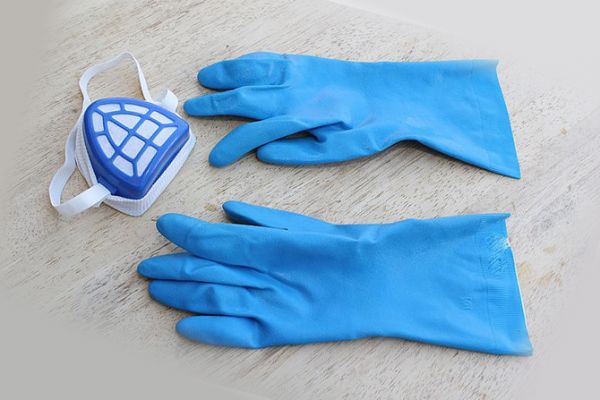

In the fight against bedbugs using kerosene, it is necessary to observe safety measures
Conclusions: all pros and cons
Destroying parasites on your own using folk methods is a rather difficult event that requires a lot of patience and painstaking work. The main rule for dealing with bed bugs is to determine their habitat. Inspect things carefully during pest control, treating each item separately. When finished, wash all bedding at a high temperature.
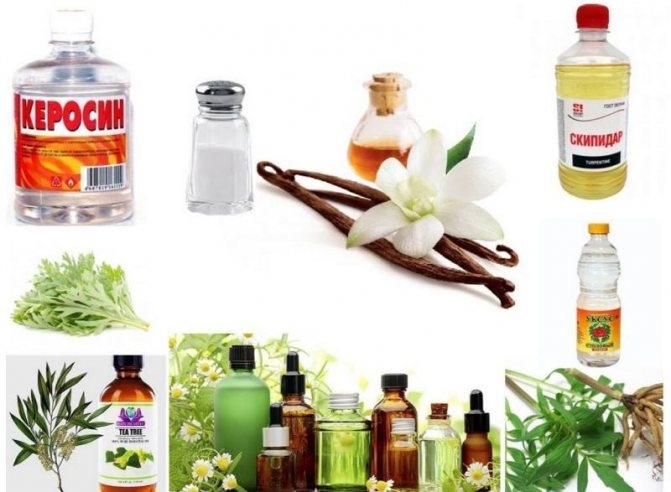

Kerosene is effective against bedbugs only when the parasites have entered the dwelling quite recently and have not had time to breed. Otherwise, it will be very difficult to get rid of them on your own, as they multiply quickly and reduce the chances of coping with them on their own.
When trying to get rid of bedbugs on your own, there may be such difficulty as the spread of parasites over an even larger territory. In addition, kerosene can cause suffocation and create a fire hazard. If pest control ended in defeat, it is better to turn to professionals who will rid the room of insects as efficiently and without harm to health.
Kerosene has been used against bedbugs for a long time. And this substance, like any other remedy, has its advantages and disadvantages.
Benefits of kerosene:
- Budget and readily available tool.
- Active substance.
- It is easy to carry out pest control with kerosene.
Disadvantages of the substance:
- New, more effective means have appeared on the modern market. Kerosene is inferior to them.
- Kerosene is flammable. Has a pungent odor, is difficult to remove from the surface and can cause poisoning.
- This substance will help to cope only with recently appeared insects before their spread and reproduction. Also, bedbugs get used to kerosene and no longer succumb to its influence.
The best option for dealing with bloodsuckers would be to contact the SES or private companies for the destruction of parasites.
How to use it correctly?
Help from the use of this tool will be complete if the fight is carried out according to all the rules. The main one is to choose the most effective method for each situation.
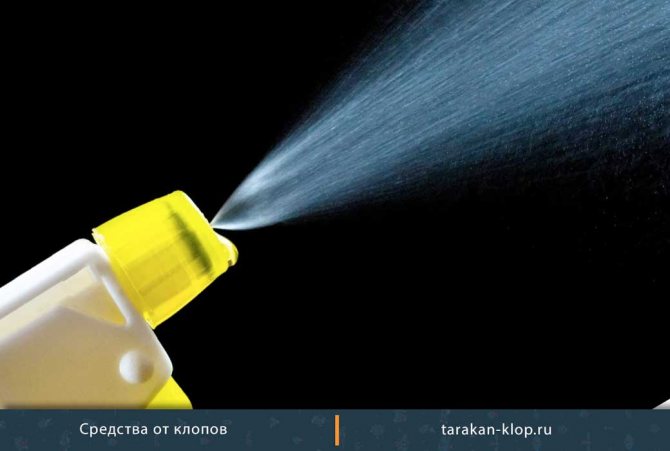

There are several methods to quickly get rid of bed bugs at home:
- Spraying with a clean solution is the most effective solution, since when spraying, the body of the bloodsucker is completely covered with a chemical reagent. Such processing is carried out behind the batteries, near the cracks in the floor and walls. Is it possible to process a room with kerosene and expect it to be released from unexpected guests for a long time? It all depends on the regularity of spraying and the persistence of insects.
- Turpentine and kerosene - after spraying a solution prepared from 12 parts of turpentine and 6 parts of kerosene (you can add 3 parts of denatured alcohol), the apartment becomes intolerable for bedbugs, and they quickly leave it.
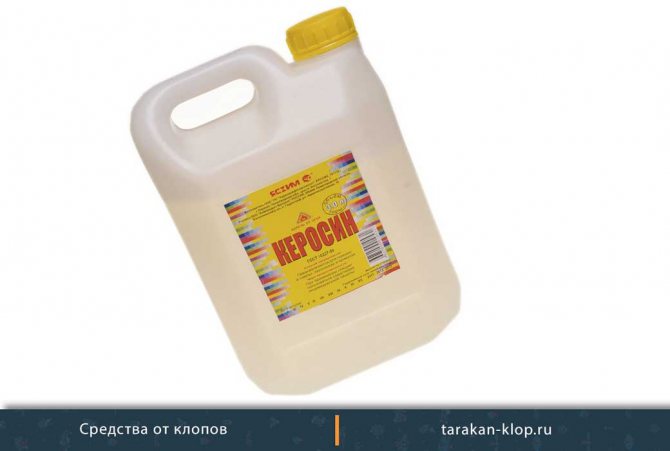

- Kerosene mixed with naphthalene will also repel insects. Processing is carried out after mixing 100 g of kerosene and 5 g of naphthalene by lubricating all surfaces in the room. The heavy odor scares off adults and encourages them to hatch indoors. However, this technique is lengthy and does not guarantee complete elimination of the problem, since the chemicals gradually disappear and the bugs can return.
- A good deterrent option in the form of mixing green soap and kerosene prevents the active reproduction of the parasite, but does not kill bed bugs. The surfaces should be lubricated regularly.
You can use the listed methods yourself. But as practice shows, it is easier to prevent such an unpleasant phenomenon as close proximity to blood-sucking insects than to get rid of them later. Prevention will help avoid negative impacts on human health. Since kerosene, being an active chemical, has a negative effect on well-being and general condition.
Old "acquaintance" - kerosene
Kerosene began to be used to combat bedbugs almost a century and a half ago - literally from the moment of its appearance. It is a yellowish oily liquid kerosene with a specific odor. It belongs to flammable hydrocarbons, boiling at a temperature of 150 degrees. Get kerosene when distilling oil.
Kerosene was first registered in 1854. In those days, it was even sold in pharmacies as a medicine. And despite the fact that kerosene, like all long liquid hydrocarbons, is poisonous, it was really used for medicinal purposes. And they still use it. But, as a poisonous substance, it was also successfully used to hunt insect parasites.

